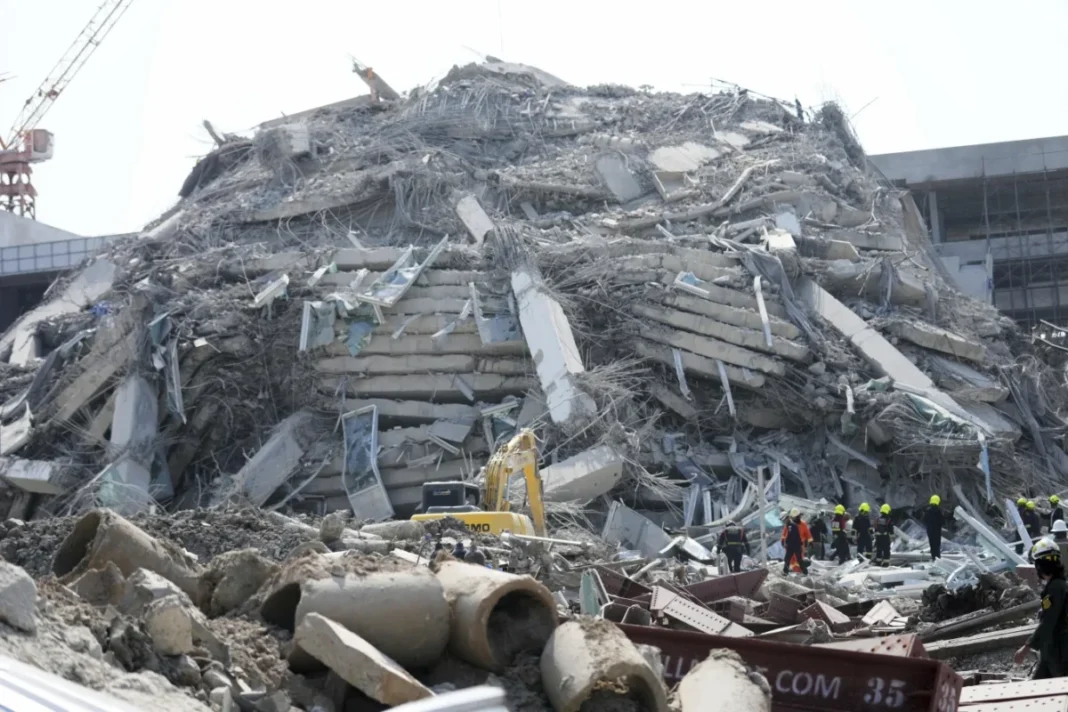Earthquake Details and Impact
A devastating earthquake struck Myanmar and neighboring Thailand on Friday, leaving widespread destruction and a rising death toll. The Myanmar military-led government confirmed on Monday that more than 1,700 people have died, while over 3,400 have been injured and more than 300 remain missing. The full extent of the disaster is still emerging as search and rescue operations continue.
The 7.7 magnitude earthquake, centered near Mandalay, Myanmar’s second-largest city, struck around midday. A powerful 6.4 magnitude aftershock followed, worsening the destruction. The disaster has significantly affected Myanmar’s capital, Naypyidaw, where multiple government buildings collapsed. The earthquake also caused widespread damage to infrastructure, including roads, bridges, and hospitals, complicating rescue efforts.
Government spokesman Maj. Gen. Zaw Min Tun told state-run MRTV that previously reported figures of 1,644 deaths had risen, but did not provide specific details. The real toll is feared to be much higher, as telecommunication outages and damage to roads have made it difficult to assess the situation in many areas.
Catastrophic Losses During Religious Gatherings
The earthquake struck during Friday prayers in the holy month of Ramadan, killing some 700 worshippers as mosques collapsed, according to Tun Kyi, a member of the Spring Revolution Myanmar Muslim Network. He also reported that at least 60 mosques suffered severe damage. It remains unclear if these figures are included in the official casualty count.
In Mandalay, 270 monks were taking a religious exam at the U Hla Thein monastery when the earthquake hit, reducing the structure to rubble. On Monday, rescue teams reported that 70 monks escaped, but 50 bodies had been recovered while 150 remained missing.
Destruction in Bangkok
Near Bangkok’s popular Chatuchak market, a 33-story high-rise under construction collapsed, killing at least 18 people. Emergency responders confirmed that 33 were injured and 78 were still missing, primarily at the construction site. Heavy equipment was shut down temporarily to allow rescuers to listen for signs of life under the debris. Bangkok Governor Chadchart Sittipunt expressed hope that survivors could still be found, stating, “Even if one life is saved, it is worth all the effort.”
Humanitarian Crisis in Myanmar Worsens
Mandalay bore the brunt of the earthquake, with historic sites such as the Ma Soe Yane monastery destroyed. A 90-year-old bridge in Sagaing collapsed, and major highways connecting Mandalay to Yangon sustained significant damage.
International rescue teams from Russia, China, India, and several Southeast Asian nations have deployed to assist in Myanmar. An Indian rescue team was seen jackhammering through slabs of fallen concrete in Mandalay, using portable generators and angle grinders to clear debris.
The World Health Organization (WHO) reported that three hospitals were completely destroyed, while 22 others suffered partial damage. WHO warned that overwhelmed healthcare facilities are in dire need of trauma and surgical supplies, blood transfusion kits, anesthetics, and mental health support.
AI Analysis and International Aid
An artificial intelligence analysis of satellite images by Microsoft’s AI for Good Lab estimated that 515 buildings in Mandalay suffered catastrophic damage, while more than 1,500 sustained moderate to severe destruction. However, these preliminary figures require on-the-ground verification.
Several countries, including the European Union, Britain, Australia, New Zealand, and South Korea, have pledged millions of dollars in aid. While U.S. President Donald Trump stated that Washington is willing to assist, no known American aid has reached Myanmar yet.
Earthquake and Civil War Complicate Rescue Efforts
Myanmar sits on the Sagaing Fault, a major north-south fault line separating the India and Sunda tectonic plates. The earthquake ruptured a 200-kilometer (125-mile) section of the fault, causing massive damage in Sagaing, Mandalay, Magway, and Bago regions, as well as Shan State.
Rescue efforts are further complicated by the country’s ongoing civil war. Since the military coup in 2021, large parts of Myanmar have been embroiled in conflict. With more than 3 million people displaced and nearly 20 million in urgent need of humanitarian aid, relief efforts face significant obstacles. Many affected areas are difficult or even impossible for aid organizations to reach.
Lauren Ellery, deputy director of programs in Myanmar for the International Rescue Committee, said the region hardest hit by the earthquake had already suffered major flooding last year and hosts a large number of internally displaced people.
“Since the earthquake, many people have been sleeping outside, either because their homes were destroyed or they fear that aftershocks might bring them down,” Ellery said. With monsoon rains expected in May, finding shelter for survivors will be a major challenge.
Authorities in Myanmar and Thailand continue to assess the full impact of the disaster, as the death toll is expected to rise further. The world watches as rescue operations unfold, hoping for more survivors to be found amidst the ruins.
—AP



